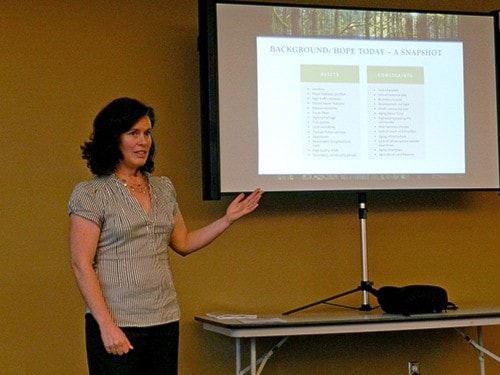The draft brand for Hope has been identified as Being Connected: to nature, to community, to yourself.
Background research, community surveys, stakeholder workshops and one-on-one conversations have all played a crucial role in shaping the community’s competitive identity.
“This isn’t perfectly refined yet,” branding coordinator Alison Harwood said during an open house Tuesday night at the rec centre.
“This is the bones, the essence of the brand.”
The brand platform is made up of five elements, which include our vision, values, offer, best personality, and positioning.
The vision for Hope is to have a vibrant downtown core with independent stores and a flourishing and inviting mountain culture, high quality of life and a place to learn and grow through adventure, and be environmentally and culturally sensitive. The things that Hope strives to value were identified as optimism with action, stewardship of environment and town, positive and progressive, and authenticity (grounded and honest).
Hope’s intimate and stunning mountain setting is the community’s ultimate selling point as it “allows one to feel alive and connected to nature, the community and oneself while maintaining comfortable access to big city amenities.” The character traits that represent Hope’s best personality are relaxed, modest and calm, easygoing and friendly, adventurous, and helpful, kind and polite. When it comes to positioning, Harwood said Hope is the transportation hub connecting the Interior with the Lower Mainland, providing a place to rest and recharge. The community is also an accessible soft adventure hub through which one can be emotionally moved by awe-inspiring natural encounters.
The foundation of the brand comprises of several attributes that the community can take ownership of. Among the physical attributes noted are walking trails to spectacular natural features, gliding, clean pure water, and a plethora of easy “experiential adventure.” The local culture, accessibility to the Lower Mainland and Interior, and affordability to live and recreate were listed as rational benefits, while emotional benefits include being content and balanced, grounded, down-to-earth, and relaxed.
Harwood pointed out that Hope’s brand doesn’t solely exist on its own, but rather is viewed in context with other brands that an audience may come in contact with. She said Hope can leverage overarching themes by crafting a local brand that is complimentary.
The next step in the branding process is distilling the wording further to make it clear, succinct and as focused as possible. Once the wording is set, the logo for Hope will be crafted. This process may or may not include a tagline or slogan, but it will echo some aspects of the brand and act as a visual thumbprint.
The final brand book will be released by June 2013.
For more information or updates, visit hopechamber.net.
